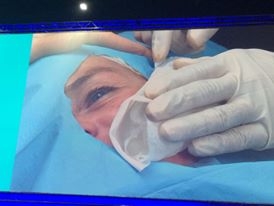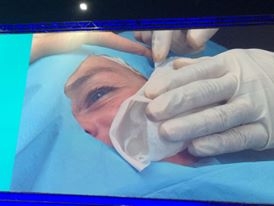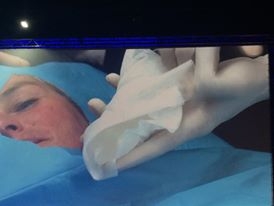Dr. R. Pizzamiglio spoke about a more complex technique for working with Silhoette soft from Sinclair. The company presents threads made of polylactic acid. Each group of four cones is located in such a way that the tops of the cones are directed towards the end of the thread closest to them, i.e. the direction of the cones in each group is opposite to the other. The new technique for introducing such threads differs in that the thread must be inserted so that the cones are located in the same direction. For this technique, it is better to use a thread with a high content of cones - it is better to choose 16 cones. The first thread that will be inserted will fix the tissues, and the second thread will have a lifting effect - a vertical lift.
If you look at how the markup is done, it becomes clear that there is a diamond-shaped zone where the threads will intersect. It is in this area that there is the highest concentration of two threads, and it is they who will create the correct lifting vector.
Starting work, we introduce a 18G needle, which will serve as a conductor for the correct location of the middle of the thread. An important detail that you should pay special attention to is that the distance between two lines of one thread should not be more than 1.5 cm. The introduction of the first part of the thread will always be easier. When introducing the second part, pay special attention to the correct insertion of the needle (first vertically, up to the mark on the needle, then horizontally). An incorrect insertion angle can cause complications.
Special attention should be paid to the introduction of the last cone. This is exactly the moment when you need to stop and check the direction with the help of an auxiliary needle. Pay attention to the introduction of threads in the temporal region. A possible complication can happen if you do not notice that the hair is caught on the cone and can be pulled subcutaneously along with the thread. This can lead to serious consequences, because. hair will be the source of the infection.
Practical advice! In order to reduce pain and relieve swelling, after the procedure, many doctors use ice. But frozen ice or cold packs are quite hard and do not give a snug fit. This, in turn, does not give a good result. In my practice, I use a different kind of cooling - condoms with a special liquid!
This is not a joke. Prepare a cocktail of 65% alcohol and water in a ratio of 2/1. Fill a condom with this cocktail and put it in the freezer. The cooling temperature will be lower than that of plain ice. The consistency of such a cold pack will be softer, and it will fit more accurately to the relief of the face, respectively - the result of cooling will be better, and patients will feel more comfortable. At the end of the procedure, when they see what was used for cooling, smiles appear on their faces. A positive mood will facilitate the rehabilitation period, which lasts 24-48 hours.










Add a comment